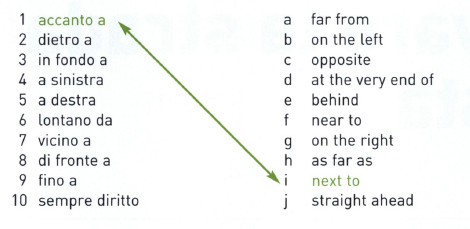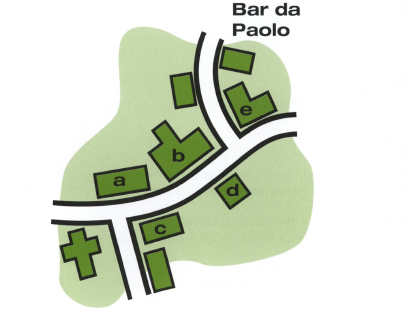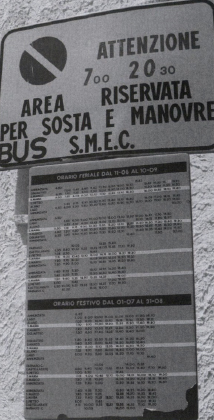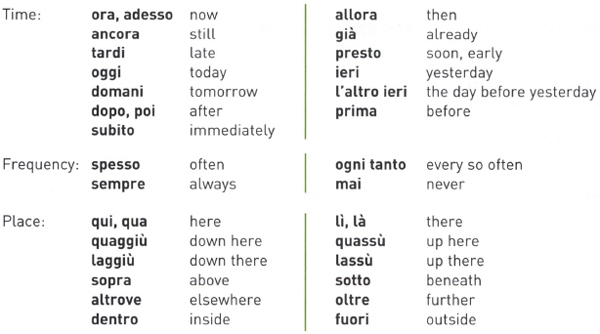
Trovare la strada giusta
FUNCTIONS |
• Specifying place |
|
• Specifying manner |
|
• Explaining where to find something, how to get there, etc. |
|
• Giving an order |
GRAMMAR |
• Prepositions expressing place: a (al), con, da (dal), in (nel), su (sul) |
|
• Adverbs and prepositions of place: vicino a, lontano da, davanti a, di fronte a |
|
• Ci meaning ‘there, to there’; used with verbs |
|
• Imperative (order) forms |
|
• Adverbs |
VOCABULARY |
• Expressions of place, situation, location |
|
• Directions |
Do you know the meaning of the following Italian words? Match them with their English equivalent. The first one is done for you.

 2 Vero o falso?
2 Vero o falso?
Listen to Martina and Claudia trying to find their way to the university (Audio 7.1) and indicate whether the following statements are true, false or uncertain by circling
V (vero), F (falso) or N (non si sa).
1 Martina e Claudia non hanno una piantina. |
V/F/N |
2 Martina chiede a un passante dov’è l’università. |
V/F/N |
3 Martina e Claudia prendono l’autobus. |
V/F/N |
4 L’università è accanto all’edicola. |
V/F/N |
5 Martina e Claudia vogliono iscriversi alla facoltà di lingue. |
V/F/N |
6 In segreteria Martina e Claudia prendono subito i moduli. |
V/F/N |
7 Dopo l’una il bar Da Paolo è sempre pieno. |
V/F/N |
 3 Martina e Claudia cercano l’università I
3 Martina e Claudia cercano l’università I
Listen to Audio 7.1 again and complete the following sentences with the correct word from the box.

1 Vedi la chiesa lì in _______ alla piazza?
2 Girate a _______.
3 Possiamo andare _______.
4 L’università è _______ all’edicola.
5 La segreteria dell’università è a piano _______.
6 Per andare al bar, vai sempre _______.
 4 Martina e Claudia cercano l’università II
4 Martina e Claudia cercano l’università II
Now listen to Audio 7.1 again and mark on the map the university building.

 5 Chiedere indicazioni
5 Chiedere indicazioni
Work in pairs. One of you plays the part of a student in Italy on holiday (Student A) looking for the Tourist Office (Ufficio Turismo). Ask a passer-by for directions. The other student (Student B) will play the passer-by. Exchange roles at the end. You should use the formal Lei form.
A: |
Say you are looking for the Tourist Office. Can he tell you where it is? |
B: |
È in Viale Vespucci. |
A: |
Ask him if you can go by foot. |
B: |
Sì, ma è piuttosto lontano da qui, ci vuole una mezz’ora. |
A: |
Ask him if you can get a bus. |
B: |
Sì, c’è il numero 12. |
A: |
Ask him where the stop is. |
B: |
La fermata è in Via Manin, non è lontano. Quando arriva al semaforo giri a destra e la fermata è davanti alla stazione. |
A: |
Thank him and ask him how long the bus takes. |
B: |
Una decina di minuti, non di più. |
Prepositions expressing location
Simple prepositions
Some of the simple prepositions seen in Unit 3 can be used to talk about location:
A to, at
A is used with a city, town or small island, regardless of whether you are staying there or going (to) there:
Restiamo a Firenze tutto il mese di luglio.
We’re staying in Florence the whole month of July.
Mio figlio va a Cuba in agosto.
My son is going to Cuba in August.
Da from, at the house/shop of
Da can mean ‘from’ a location:
Veniamo da Sondrio.
We’re coming from Sondrio.
Da is also used to talk about being at or going to the house, shop or restaurant of someone and can be used just with the person’s name:
Andiamo a mangiare la pizza da Pasquale?
Shall we go and eat pizza at Pasquale’s?

In in, on
In on its own (no article) is used for the commonest locations:
Sono in ufficio.
I’m in the office.
Quest’anno facciamo le vacanze in montagna.
We’re holidaying in the mountains this year.
La villa è in collina.
The villa is on the hillside.
The combined forms are used to express the concept of ‘inside’ a location:
nel ristorante |
in the restaurant |
nello sgabuzzino |
in the cupboard (under the stairs) |
nei giardini botanici |
in the botanic gardens |
É meglio conservare il sugo nel frigo.
It’s best to keep the sauce in the fridge.
Su on
sull’isola |
on the island |
sui gradini |
on the steps |
Lascia sempre il telefonino sulla scrivania.
He always leaves his mobile on the desk.
Tra/Fra between
La mia casa si trova tra la piazza e Viale Veneto.
My house is between the piazza and Viale Veneto.
Adverbs used as prepositions
Some adverbs of location when used as prepositions require a:

Mia madre abita di fronte.
My mother lives opposite.
La signora abita di fronte a me.
The lady lives opposite me.
La casa è vicino al mare.
The house is near the sea.
Certain prepositions need di only before pronouns such as me, te, lui, lei:

Ci
Ci is used to mean ‘there’ or to there’ but also to express the idea of ‘to it’ or at it’:
Abiti a Roma? Si, ci abito da cinque anni.
Do you live in Rome? Yes, I’ve lived there for five years.
Vai in Italia quest’estate? Si, ci vado il 5 luglio.
Are you going to Italy this summer? Yes, I’m going there on 5 July.
Verbs used with ci include capire ‘to understand’, contare ‘to count’, pensare ‘to think’ and verbs of the senses such as vedere ‘to see’, sentire ‘to hear’, toccare ‘to touch’. Note also volerci ‘to take time’, (see Unit 3).
I verbi italiani sono troppo difficili. Non ci capisco niente.
Italian verbs are too difficult. I can’t understand anything.
Vieni alla mia festa? lo ci conto.
Are you coming to my party? I’m counting on it.
Pensi spesso a quella storia? Si, ci penso spesso.
Do you often think about that affair? Yes, I think of it a lot.
Ci vedi?
Can you see anything?
Ci senti?
Can you hear anything?
Answer the questions, using a preposition or combined preposition. More than one answer is possible and some possible answers are provided.
Example
Dov’è il burro? (frigorifero)
È nel frigorifero.
1 Dove passate le vacanze? (montagna, mare)
2 Dove mettete le scarpe? (armadio, scarpiera)
3 Dove lasciate la macchina? (garage, strada)
4 Dove studiate? (scuola, università)
5 Dove abita tua cugina? (zia, madre)
6 Dove fanno il film? (cinema)
7 Dove giocano a calcio? (stadio)
8 Dove sono Carlo e Mario? (cucina, bagno)
 7 Ci
7 Ci
Answer the following questions in the affirmative using ci.
Example
Vai al bar stasera?
Sì ci vado.
1 Andate in segreteria? (adesso)
2 Vai a Londra sabato? (in autobus)
3 Andiamo agli Uffizi quando siamo a Firenze? (insieme)
4 I ragazzi vanno a vedere Il lago dei cigni? (sabato pomeriggio)
5 Emma, torni in Italia per Natale? (in aereo)
6 Vittoria, i tuoi genitori vanno alla messa? (ogni domenica)
 8 Verbs + ci
8 Verbs + ci
Give a negative reply to the following questions, using a combination of ci and the following verbs: capire, contare, pensare, sentire, vedere.
Example
Pensi spesso alla tua ragazza?
No, non ci penso mai!
1 Capite quello che dice l’insegnante?
2 Pensi a quel che ti dico?
3 Sentite lo stesso se abbassiamo un po’ il volume dello stereo?
4 Posso contare sul vostro aiuto?
5 Ma riesci a vedere con la luce spenta?
Giving orders and instructions
To give orders or directions, Italian uses a command or imperative form. It has different forms for tu, Lei, noi, voi, loro which depend on the type of verb used, and it has different forms for the negative. Here are three different examples for the tu form:
Mangia una pasta di mandorla!
Eat an almond cake!
Prendi un succo di frutta, Cristina!
Have a fruit juice, Cristina.
Non fare complimenti!
Don’t stand on ceremony!
Two very common uses of the imperative are to call someone’s attention (e.g. waiter, passer-by) and to ask or give directions:
Senta! Scusi! Dov’e la fermata dell’autobus?
Listen. Excuse me. Where is the bus stop?
Prenda Via Garibaldi. Vada sempre diritto. Al primo semaforo giri a sinistra!
Take Via Garibaldi. Go straight on. At the first traffic lights turn left.
Here are the different forms of the imperative for different persons of the verb and for different groups of regular verbs.

The Lei form should be used when addressing someone you are not familiar with:
Faccia pure!
Please feel free!
The noi form is a suggestion for yourself and your friends, rather than an order.
Andiamo in centro!
Let’s go to the centre!
The polite plural Loro form is seldom used, except by waiters (see Unit 4) or hotel staff, in set courtesy phrases such as:
Si accomodino, signorine.
Please take a seat, ladies.
Using the infinitive
Recipes, instruction manuals and other written instructions often use the infinitive (the ‘to’ form of the verb):
Aprire con cautela. (on a packet or tin)
Open with care.
Telling someone not to do something
For the Lei, noi, voi and Loro forms, add non before the verb:
Non si preoccupi, signora! |
Don’t worry, signora! |
Non andiamo alla festa! |
Let’s not go to the party. |
Non girate a sinistra! |
Don’t turn left! |
For the tu form, use non and the infinitive (-are, -ere, -ire):
Non mangiare troppo! |
Don’t eat too much! |
Non dormire fino a tardi! |
Don’t sleep in! |
Non is also added to instructions given in the infinitive:
Non parlare con il conducente! |
Don’t speak to the driver! |
Irregular forms of the imperative
Many verbs have an imperative form which does not follow the form shown above. Some of the most common irregular imperative forms are:
The one-syllable imperatives of andare, dare, dire, fare, stare shown above are often spelt differently: va, dà, dì, fà, sta. Perhaps because they sound so abrupt, there is a tendency anyway for four of them to be replaced by the normal tu forms: vai, dai, fai, stai.
Adverbs
Introduction
Adverbs are words which modify the meaning of a verb, in the same way that an adjective qualifies a noun:
L’italiano è una lingua facile. (adjective)
Italian is an easy language.
L’italiano si impara facilmente. (adverb)
Italian can be learnt easily.
Adverbs are invariable, i.e. their form does not change. Most adverbs are formed from the related adjective, simply by adding the suffix -mente.
Adverbs formed from adjectives
For adjectives of the -o/-a/-i/-e type, add -mente to the feminine singular form:
attento |
attentamente |
For adjectives of the -e/-i type, add -mente to the singular form:
semplice |
semplicemente |
With adjectives ending in -le and -re, the e is dropped before adding -mente:
facile |
facilmente |
particolare |
particolarmente |
Adverbs not formed from adjectives
Adverbs not formed from adjectives include adverbs of degree, time, frequency, place and other common adverbs. Here are just a few examples:

Adverbs of degree can also be used to modify adjectives or even other adverbs:
L’italiano è una lingua molto facile.
Italian is a very easy language.
L’italiano si impara molto facilmente.
Italian can be learnt very easily.


(All sometimes preceded by a)

Some adverbs of time and place such as davanti, dentro, dietro, dopo, fuori, oltre, prima, sopra, sotto are also used as prepositions. See Grammar Notes I.
Adjectives used as adverbs
It’s very common to use the masculine singular adjective form instead of the adverb, especially in spoken Italian and in advertising:
Non parlare veloce (velocemente). Parla chiaro (chiaramente).
Don’t speak fast. Speak clearly.
Chi va piano va sano e va lontano.
He who goes slowly goes safely and goes far.
Prepositional phrases used as adverbs
It’s also common to use phrases consisting of preposition and noun, for example:
Guida con molta attenzione.
He drives with great care.
Gli studenti adulti studiano in modo autonomo.
Adult students study independently.
Suffixes
Adding a suffix such as ino, -uccio to common adverbs – a usage mainly limited to spoken Italian – can convey limited intensity (‘quite’), or a particular tone, such as affection:
Ha solo due anni, ma parla benino.
She’s only two years old, but she speaks quite well.
Come ti senti adesso? Maluccio.
How do you feel now? Quite bad.
 9 Adverbs and adverbial phrases
9 Adverbs and adverbial phrases
Substitute the adverbial phrases underlined with an adverb as shown in the example.
Example
Carlotta ha all’improvviso deciso di tornare a vivere in Italia.
Carlotta ha improvvisamente deciso di tornare in Italia.
1 Ascolta con attenzione quello che sto per dirti.
2 Con questo traffico con difficoltà riusciremo ad arrivare prima di sera.
3 Perché non ripeti con precisione le parole di Stefano?
4 Ho preso quella curva con troppa velocità.
5 Il nostro lavoro procede con lentezza.
6 Hanno esposto con chiarezza il loro punto di vista.
 10 Imperative forms voi
10 Imperative forms voi
Text 7.1 Il decalogo dell’eco-turista
Read the following passage, identifying all the voi imperative (order) forms of the verbs and highlighting them.
I nostri viaggi hanno un notevole impatto sulle condizioni ambientali e socio-economiche dei paesi che visitiamo. Ecco il decalogo (= le regole) per i turisti responsabili che scelgono di rispettare il pianeta e i suoi abitanti:
1 Preferite paesi e località che hanno adottato appropriate misure di protezione del loro patrimonio naturale e rispettano i diritti umani.
2 Informatevi sulla cultura ed abitudini della società che visitate per non offendere la natura e le popolazioni locali.
3 Il denaro portato dai turisti ha spesso un grande valore per le popolazioni locali. Cercate di usufruire dei servizi offerti dalle popolazioni locali piuttosto che quelli delle compagnie straniere. Scegliete alberghi e ristoranti a gestione familiare e non appartenenti a imprenditori stranieri.
4 Adattatevi alle abitudini locali. Accettate la cultura gastronomica del paese e non cercate la vostra.
5 Non raccogliete conchiglie, sassi, fiori. Non distruggete e non impoverite l’habitat naturale in cui vivono gli animali.
6 Non inquinate e non lasciate tracce del vostro passaggio.
7 Nell’acquistare souvenir cercate prodotti di artigianato locali, ma non scegliete souvenir che implicano il sacrificio di specie animali e vegetali a rischio.
8 Visitate parchi e riserve, il cui sostentamento dipende in parte dal contributo economico del turismo.
9 Viaggiate fuori stagione per non contruibuire agli affollamenti che danneggiano l’ambiente.
10 Non ostentate ricchezza e lusso stridenti rispetto al tenore di vita del paese che visitate e non assumete comportamenti offensivi per usi e costumi locali.
Adapted from www.archibio.com/artille.php?ID_ARTICOLO= 50
 11 Imperative forms tu
11 Imperative forms tu
Now re-write the ten instructions from Text 7.1 Il decalogo dell’eco-turista, changing the voi imperative form to the tu imperative. Don’t forget to change pronouns and adjectives where necessary. The first one is done for you.
1 Preferisci paesi e località che hanno adottato appropriate misure di protezione del loro patrimonio naturale e rispettano i diritti umani.
 12 ll decalogo del perfetto turista al mare
12 ll decalogo del perfetto turista al mare
Now read Text 7.2 below before drawing up a Decalogo del perfetto turista al mare using the voi imperative form, telling tourists how to behave at the beach. There are ten rules and the first rule is done for you below.
Text 7.2 Consigli per le vacanze al mare
Il decalogo del perfetto turista stilato dal Sindacato italiano balneatori Buona educazione e rispetto del vicino d’ombrellone
Come trascorrere serenamente al mare le vacanze. I titolari degli stabilimenti balneari associati al Sib (Sindacato italiano balneari) pubblicano un decalogo, dieci consigli utili che bisogna seguire. Il presidente del Sib dice che bisogna rispettare le regole elementari per vivere in armonia con i vicini d’ombrellone. Ma veniamo ai dieci utili consigli per le vacanze al mare. In cabina bisogna depositare tutti gli oggetti personali e vestiti che non devono essere ammucchiati sulla spiaggia né sotto gli ombrelloni. Non bisogna ingombrare i corridoi e i passaggi al mare. La Sib ricorda ai bagnanti che devono depositare le carte e i rifiuti negli appositi contenitori e non devono gettare le cicche nella sabbia.
E poi? È buona norma non usare gli apparecchi radio e i telefoni cellulari ad alto volume, magari con le cuffie e soprattutto avere la suoneria al minimo conversando a bassa voce. Ma una cosa è molto importante in termini di sicurezza: dovete fare il bagno solo tre ore dopo l’ultimo pasto e non affrontare i pericoli del mare quando è issata la bandiera rossa. Infine il Sindacato balneatori invita a rispettare gli orari di apertura e chiusura degli stabilimenti. Per qualsiasi necessità è consigliabile rivolgersi al personale addetto. I turisti devono giocare a palla o praticare altri giochi nei siti allestiti allo scopo.
Il decalogo del perfetto turista al mare
1 Depositate oggetti personali e indumenti in cabina e non ammucchiateli sotto l’ombrellone.
2 ______________________________________________________________
3 ______________________________________________________________
4 ______________________________________________________________
5 ______________________________________________________________
6 ______________________________________________________________
7 ______________________________________________________________
8 ______________________________________________________________
9 ______________________________________________________________
10 ______________________________________________________________
Adapted from www.adnkronos.com/news/prod/bolletti/storia/2001/turago2.htm
 13 Consigli per le vacanze al mare
13 Consigli per le vacanze al mare
After checking your final list with the Answer key, discuss in pairs. Which of the following situations would you find most irritating when sunbathing on a beach?
• Il tuo vicino d’ombrellone sta telefonando a tutti i suoi parenti per dire loro che si trova al mare. Sta parlando a voce molto alta.
• Tu stai cercando di leggere un libro e i tuoi vicini d’ombrellone hanno il volume della radio molto alto.
• Un gruppo di ragazzi sta giocando a pallone e il tuo ombrellone è in prima fila.
 14 Synonyms
14 Synonyms
For each word given in the left-hand column, find the synonym in the right-hand column. The first one is done for you.

 15 Giving orders: tu, Lei forms
15 Giving orders: tu, Lei forms
The instructions/orders below are given in the voi form. Change them using:
a the tu form of the imperative
b the Lei form of the imperative
Example
Non gettate rifiuti nel bosco!
a Non gettare rifiuti. (tu form)
b Non getti rifiuti. (Lei form)
1 Non alzate il volume della radio!
2 Non raccogliete troppi funghi!
3 Non raccogliete i fiori!
4 Non spezzate i rami degli alberi!
5 Non disturbate gli animali!
6 Non tenete il telefonino sempre acceso!
7 Non portate troppi bagagli!
8 Godetevi la vacanza!
Complete the instructions or orders given below, adding the tu form of the imperative of the verbs in the box.

Example
_____________ più tollerante!
Sii più tollerante!
1 _____________ meno fretta!
2 _____________ attenzione a ciò che dice!
3 _____________ attenta alla macchina!
4 _____________ al ristorante con noi!
5 _____________ a vedere cosa vuole Alberto!
6 _____________ allo specchio!
7 _____________ appena puoi!
8 _____________, sono tre ore che dormi!
9 _____________ questo libro, voglio leggerlo anch’io!
 17 Imperative form (tu, Lei, voi forms)
17 Imperative form (tu, Lei, voi forms)
Fill in the blanks with the correct form of the imperative, using the tu, Lei or voi form as appropriate.
Example
Percorra tutto il viale e poi __________ a destra. a gira b giri c girate
Percorra tutto il viale e poi giri a destra.
1 Continuate sempre dritto e quando arrivate alla stazione _____________.
a chiedate
b chiedete c chiedi
2 Prenda l’autobus numero 2 e __________ in Piazza Manin.
a scendi
b scenda
c scende
3 Vedi la posta? Quando arrivi lì, __________ la strada e vedrai il duomo.
a attraversi
b attraversa
c attraverso
4 __________, mi sa dire dove posso comprare una scheda telefonica?
a scusi
b scusa
c mi scusa
5 Il museo d’arte moderna? È vicino, (Lei) __________ le indicazioni per il duomo, il museo è nella stessa piazza.
a segui
b segua
c segue
6 Domani mattina troverai la coda alla biglietteria, __________ il biglietto adesso.
a compra
b comprate
c compri
7 __________ vicini, vi faccio una foto davanti la fontana!
a mettetevi
b vi mettete
c vi metta
8 __________ di portare con te un documento.
a ricordatevi
b ti ricordo
c ricordati
9 Non __________ di portare il computer.
a ti dimentichi
b dimenticare
c dimenticarvi
KEY VOCABULARY
Means of transport
